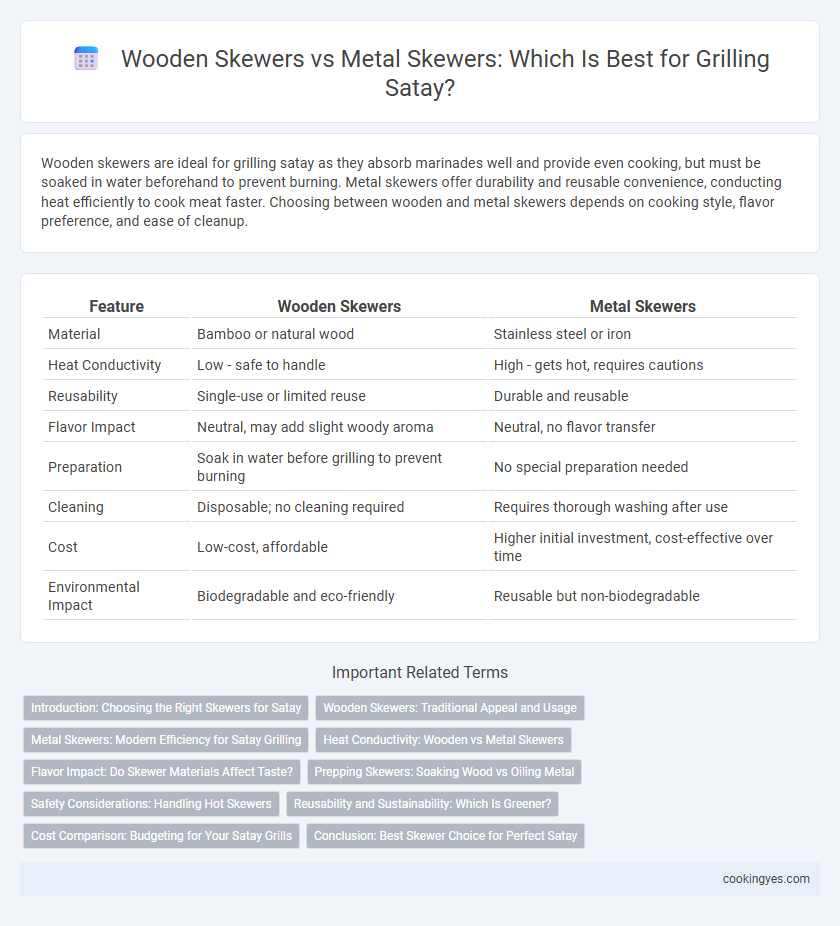Wooden skewers are ideal for grilling satay as they absorb marinades well and provide even cooking, but must be soaked in water beforehand to prevent burning. Metal skewers offer durability and reusable convenience, conducting heat efficiently to cook meat faster. Choosing between wooden and metal skewers depends on cooking style, flavor preference, and ease of cleanup.
Table of Comparison
| Feature | Wooden Skewers | Metal Skewers |
|---|---|---|
| Material | Bamboo or natural wood | Stainless steel or iron |
| Heat Conductivity | Low - safe to handle | High - gets hot, requires cautions |
| Reusability | Single-use or limited reuse | Durable and reusable |
| Flavor Impact | Neutral, may add slight woody aroma | Neutral, no flavor transfer |
| Preparation | Soak in water before grilling to prevent burning | No special preparation needed |
| Cleaning | Disposable; no cleaning required | Requires thorough washing after use |
| Cost | Low-cost, affordable | Higher initial investment, cost-effective over time |
| Environmental Impact | Biodegradable and eco-friendly | Reusable but non-biodegradable |
Introduction: Choosing the Right Skewers for Satay
Wooden skewers are popular for satay grilling due to their disposable convenience and natural flavor absorption, but require soaking to prevent burning. Metal skewers offer durability and superior heat conduction, ensuring even cooking and easy reuse. Selecting the right skewer depends on balancing convenience, heat distribution, and flavor preferences for optimal satay grilling results.
Wooden Skewers: Traditional Appeal and Usage
Wooden skewers are the traditional choice for grilling satay, offering authentic flavor and an easy, disposable option that absorbs marinade well. They are typically made from bamboo or hardwood, which provides stability and prevents burning when soaked in water before grilling. Their lightweight structure enhances handling and presentation, making them ideal for authentic satay preparation at home or in street food settings.
Metal Skewers: Modern Efficiency for Satay Grilling
Metal skewers offer superior heat conduction, ensuring even cooking and a perfectly grilled satay every time. Their durability and reusability make them an eco-friendly alternative to wooden skewers, while stainless steel options resist rust and are easy to clean. Metal skewers also provide better stability for handling large or densely packed satay pieces, enhancing grilling precision and efficiency.
Heat Conductivity: Wooden vs Metal Skewers
Wooden skewers offer low heat conductivity, preventing food from overcooking near the skewer and reducing the risk of burns, making them ideal for delicate satay pieces. Metal skewers conduct heat efficiently, promoting even cooking from the inside out but require careful handling due to their high surface temperature. Selecting between wooden and metal skewers depends on desired cooking control and safety preferences during satay grilling.
Flavor Impact: Do Skewer Materials Affect Taste?
Wooden skewers subtly enhance satay's flavor by imparting a mild smoky aroma during grilling, which metal skewers lack due to their heat conductivity and inert nature. Metal skewers heat more evenly, promoting uniform cooking but do not contribute to taste, making flavor solely dependent on marination and meat quality. Choosing wooden skewers can enrich the sensory experience of satay, while metal skewers offer durability and reusability without altering flavor profiles.
Prepping Skewers: Soaking Wood vs Oiling Metal
Wooden skewers require soaking in water for at least 30 minutes before grilling satay to prevent burning and ensure even cooking. Metal skewers, on the other hand, benefit from a light coating of oil to prevent meat from sticking and to facilitate easy cleaning. Proper preparation of skewers enhances the grilling process, resulting in tender, flavorful satay with well-preserved presentation.
Safety Considerations: Handling Hot Skewers
Wooden skewers are prone to burning and splintering if not properly soaked in water before grilling satay, posing a risk of accidental burns or injury during handling. Metal skewers, typically made of stainless steel, conduct heat more efficiently and can become extremely hot, requiring heat-resistant gloves for safe handling. Choosing the appropriate skewer involves balancing heat conductivity and safety precautions to prevent burns while grilling satay.
Reusability and Sustainability: Which Is Greener?
Wooden skewers are typically single-use, biodegradable, and compostable, making them environmentally friendly but less durable for multiple uses. Metal skewers offer high reusability, reducing waste over time, though their production involves higher initial energy consumption and resource use. Considering sustainability, metal skewers present a greener option when reused extensively, while wooden skewers remain eco-friendly for disposable, low-impact grilling.
Cost Comparison: Budgeting for Your Satay Grills
Wooden skewers for grilling satay typically cost less upfront, making them a budget-friendly option for large-scale cooking, while metal skewers involve a higher initial investment but offer long-term durability and reuse. The cost per use of metal skewers decreases over time as they can be cleaned and reused indefinitely, in contrast to wooden skewers, which are disposable and require constant repurchasing. Considering both upfront expenses and longevity is essential for accurate budgeting when planning satay grills.
Conclusion: Best Skewer Choice for Perfect Satay
Wooden skewers offer a natural, disposable option that imparts subtle smoky flavors to satay while being budget-friendly and easy to handle. Metal skewers provide superior heat conduction for even cooking and durability, making them ideal for repeated use and precise grilling control. Choosing wooden skewers suits casual or single-use cooking, whereas metal skewers excel in professional or frequent grilling scenarios to achieve consistent, perfectly cooked satay.
Wooden skewers vs metal skewers for grilling satay Infographic

 cookingyes.com
cookingyes.com